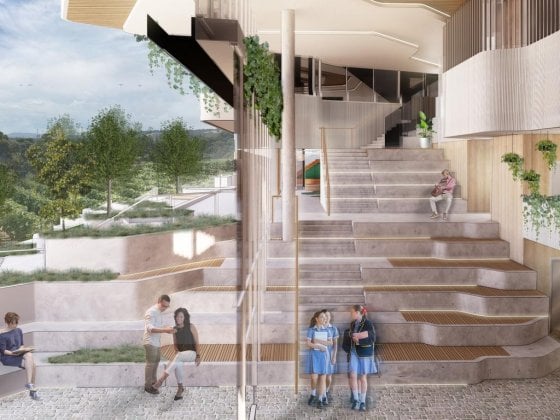A $27m development at Scotch College Adelaide will enfold wellbeing around students and open up the school to the broader community.
Students will be offered a range of sports and extensive health and wellbeing services from professional providers in a program fully integrated with core school activities.
Going beyond that to provide access after school hours to the public was part of the ethic of “showing social responsibility”, principal John Newton said.
The new buildings include a multi-use indoor sports centre, 25m indoor swimming pool, work spaces, consulting rooms and a cafe with sweeping views over Adelaide.
“Sports clubs – swimming, netball, basketball and so on – will be able to use the centre,” Dr Newton said.
“We’ve designed the building to be public-facing so that after school hours allied health professionals will have access.
“And the function spaces can be used by the public and businesses.”

Approaches to student wellbeing had evolved considerably, Dr Newton said.
In earlier eras, a student would talk to a teacher or mentor, then schools introduced counsellors and later psychologists.
The new program would go much further with nutritionists, experts on young people and electronic devices, speech therapists, occupational therapists and other specialists being engaged.
“It will be at an individual level, personalisation will be a bigger part of education going forward,” Dr Newton said.
Scotch council chair Raymond Spencer said wellbeing was not regarded as a bolt-on to teaching.
“It’s woven into everything,” he said.
Dr Newton said the accelerated pace of change in the world was “creating enormous opportunities but also presenting massive challenges and placing unprecedented stresses on individuals, communities and existing social structures”.
“The project emphasises the centrality of wellbeing and mental health at our school because that is a critical factor in any organisation,” he said.
“We plan for this facility not to be an ivory tower but to provide a beacon for wellbeing in the Scotch community and more widely for other schools and communities around Australia and globally.”
Year 6 student Jessie Merrigan said she was looking forward to the new opportunities.
“We can do our healthy minds class there – which I love – while overlooking the farm,” she said.
Year 9 student from near Penola Tom Moorhouse said boarders would enjoy the extra facilities.
Learning about wellbeing helped students “to manage changes going on around you and to understand how your mind and body work together to live a good life”.
Dual Olympic gold medallist in hockey Juliet Haslam, a Scotch graduate from 1986 and now parent of two boys at Scotch, said wellbeing was deeply embedded in the school’s philosophy.
“We’re four generations now at the school,” she said.
“We know it’s not just about academics, or sport or community – it’s about the whole lot, it’s about producing well-rounded students.”


The Scotch College Wellbeing and Sports Centre – to be built alongside Blythewood Rd – has been designed by national architectural firm Hames Sharley and will be the largest building project in the College’s 100-year history. It is the first component of a 30-year infrastructure masterplan spanning the College’s Mitcham and Torrens Park Campuses.
The building will promote sustainability. Solar power and water capture are integral in its design and internal and external vegetation will complement the College farm which is adjacent to the site.
Full details of opening up the centre were yet to be decided with the buildings scheduled to open in 2022.
Work will start next month, with the centre due to open in the first half of 2022.
This is a wellbeing hub that will connect and bring together students, families and the broader community – not just a building. The centre will be accessible by two main roads, bringing the once isolated agricultural land into the centre of the school and its day to day activities, connecting both Mitcham and Torrens Park Campus students. It is designed to be regenerative rather than just reducing negative impact. This approach complements the school’s views on wellbeing and global responsibility.